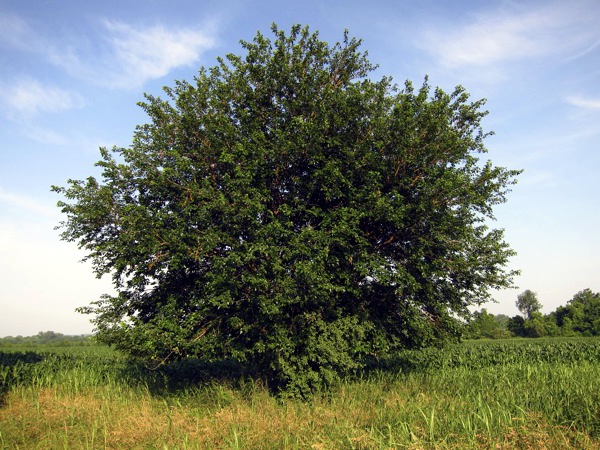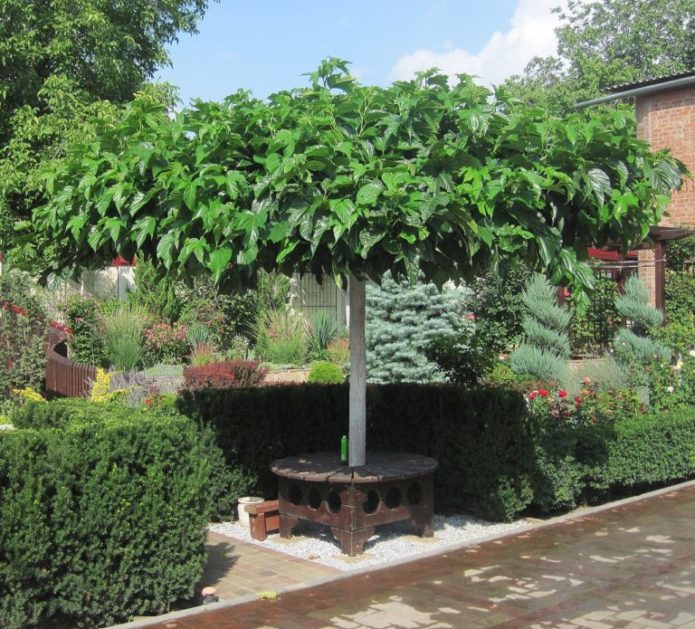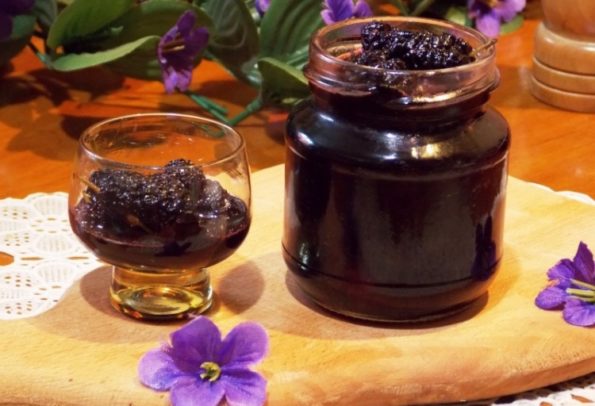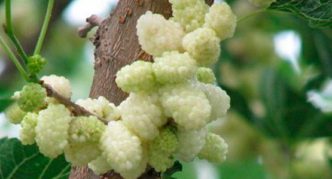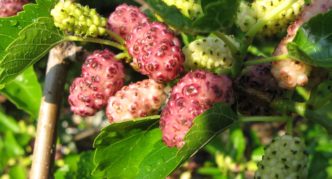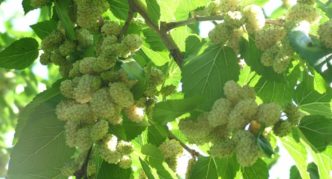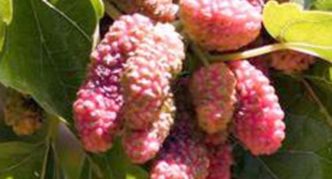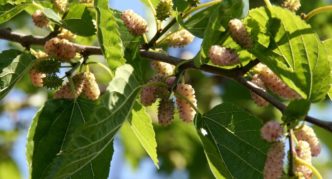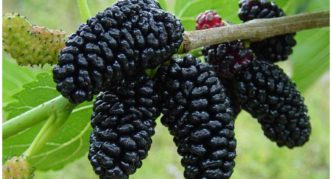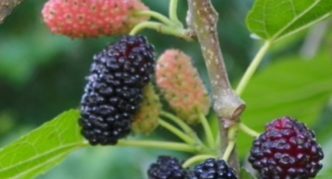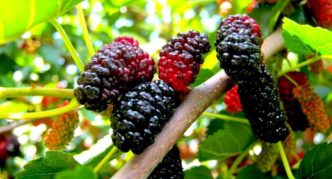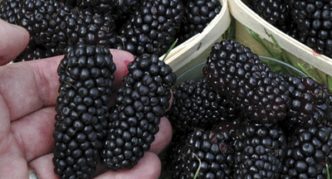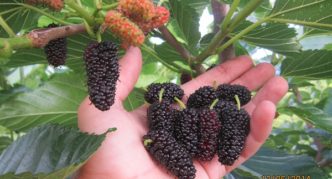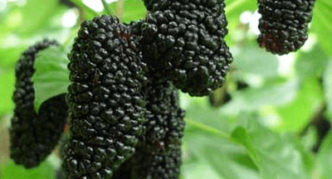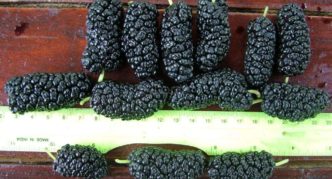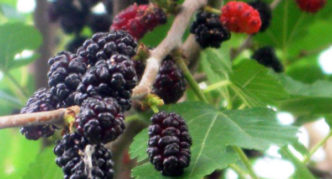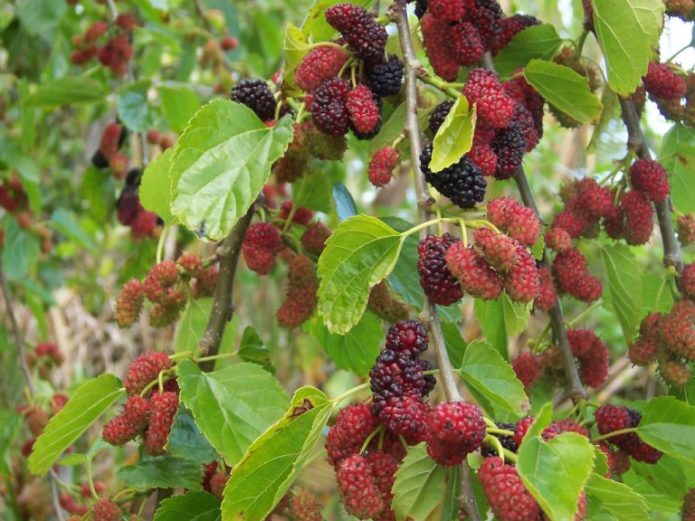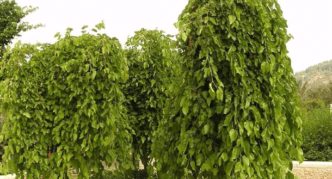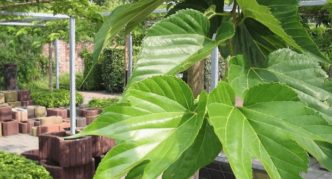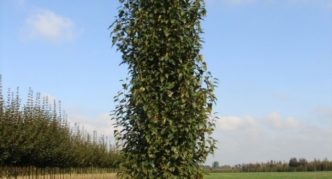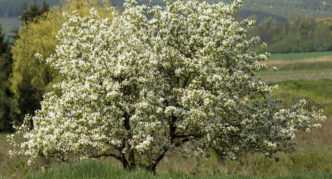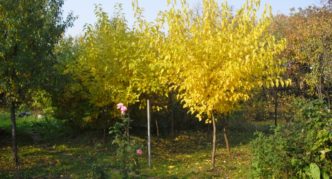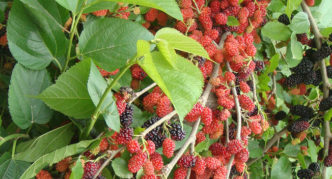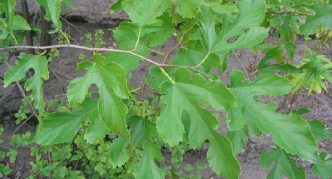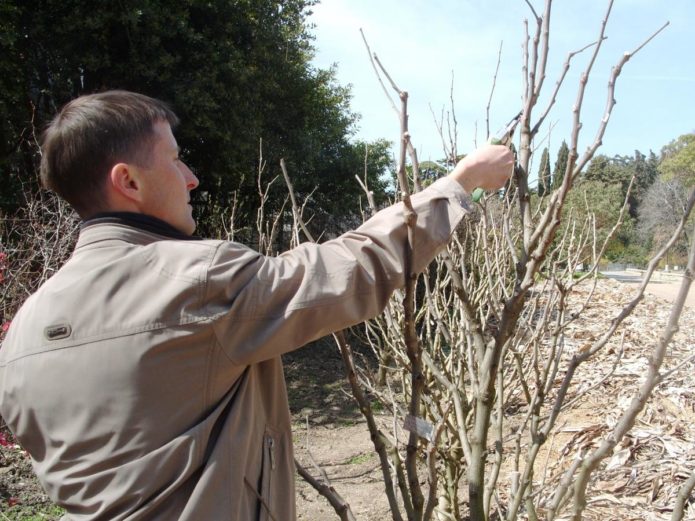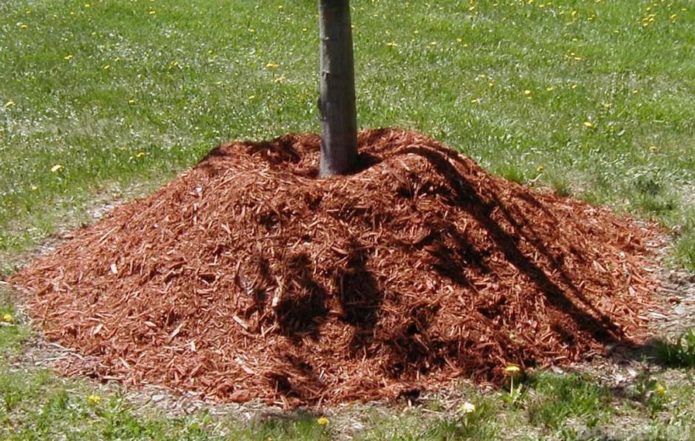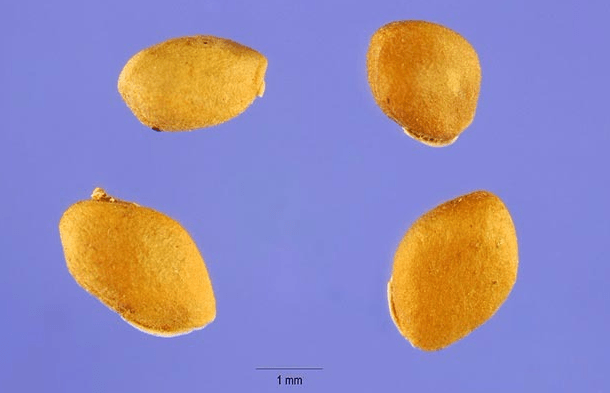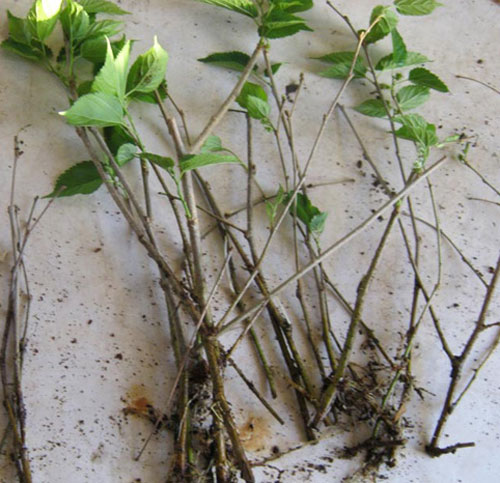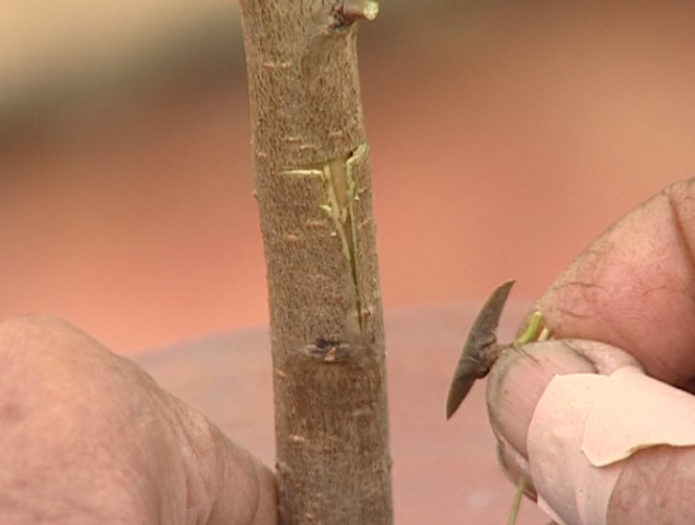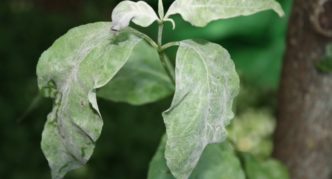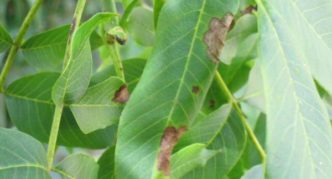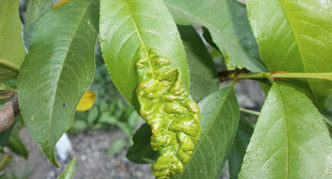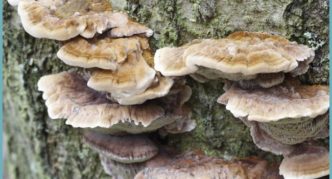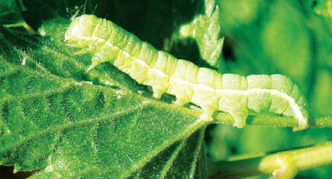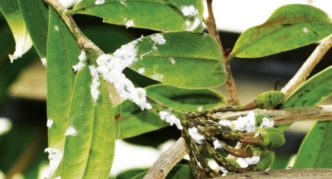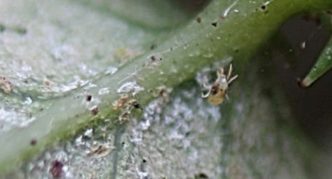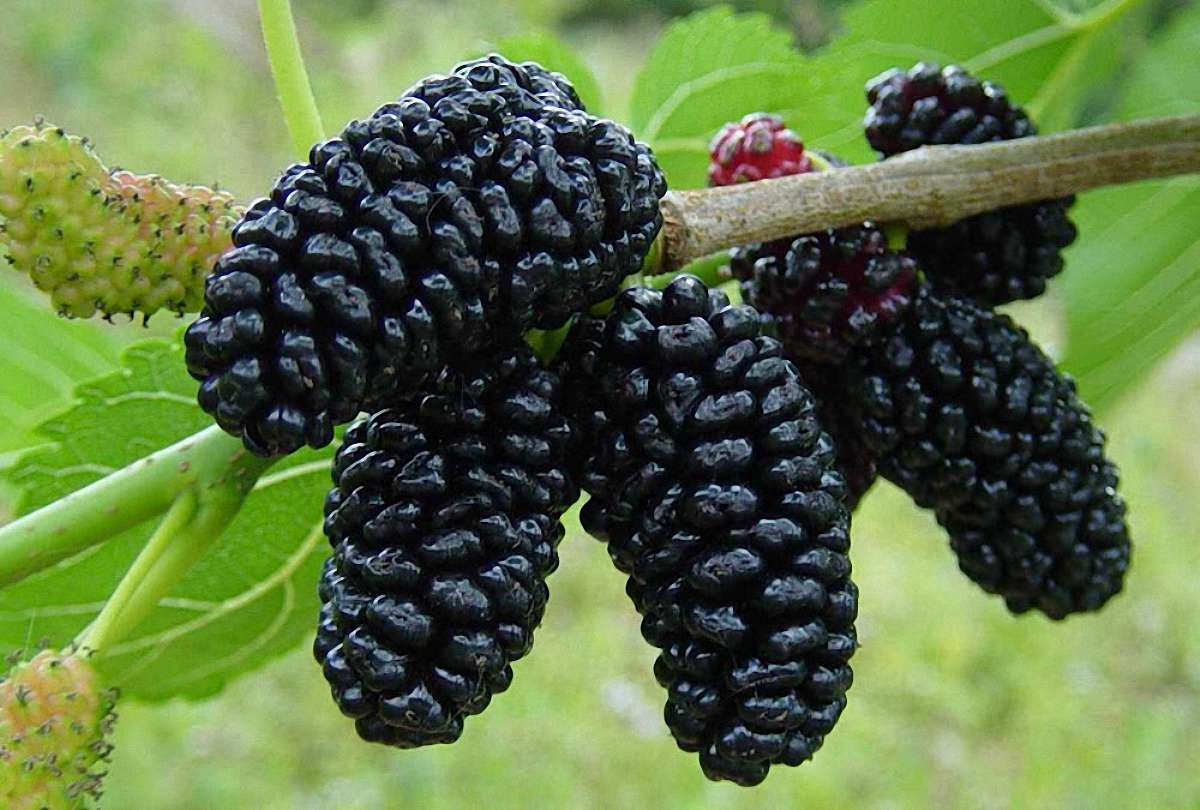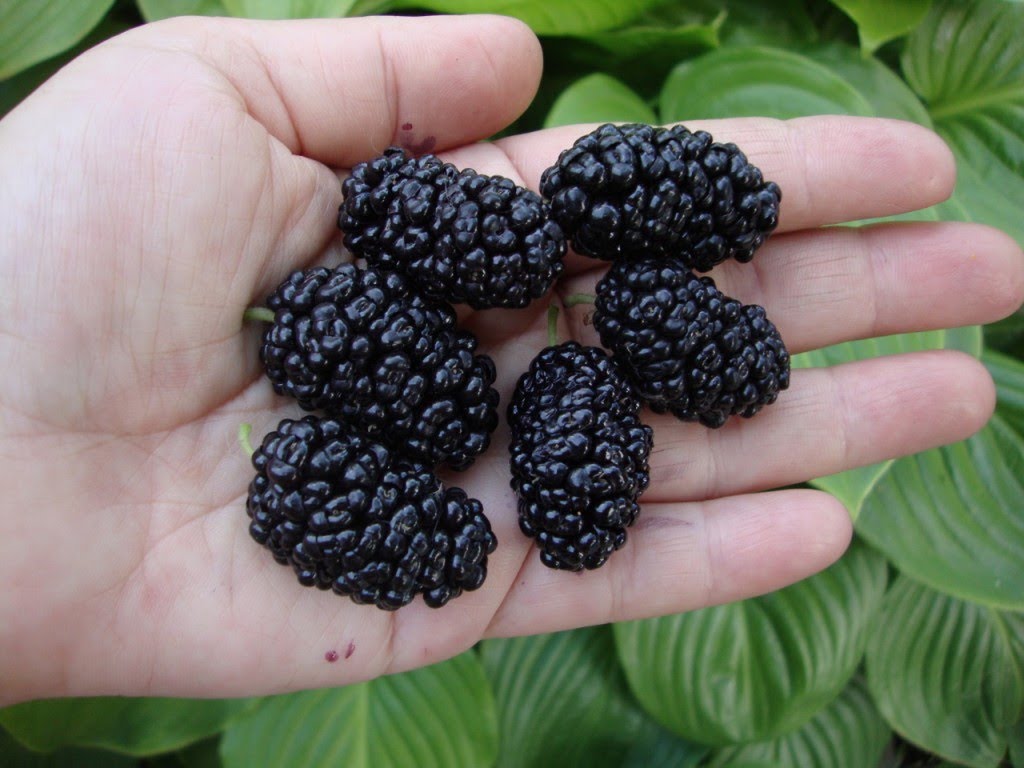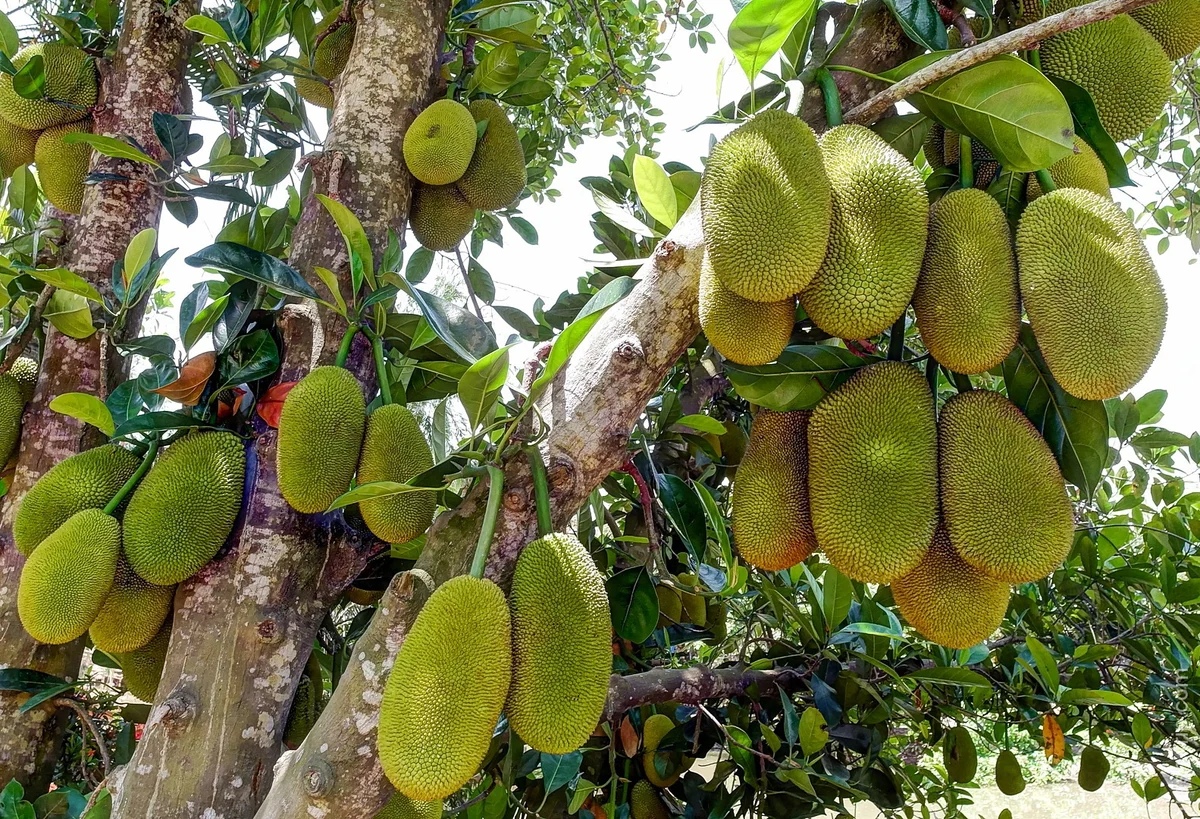Mulberry is a thermophilic plant, so it is relatively rare in the gardens of Russian gardeners. But its berries are not only delicious, but also very healthy. Also, the culture is valued for the abundance of fruiting and the length of the productive period. The tree cannot be called capricious and demanding in care - even an inexperienced gardener can do the necessary agrotechnical procedures.
Content
What does mulberry look like?
The mulberry, also known as the mulberry tree, is a small genus of deciduous trees belonging to the Mulberry family. According to various sources, there are from 10 to 16 of its representatives in nature. Most of them can be found in Central Asia and the Mediterranean coast.
A mature tree reaches 10-30 meters in height. A young seedling grows quickly, then the growth rate slows down. Mulberry leaves are of different sizes, can be either simple or cut in the form of "lobes", smooth or with jagged edges.
Mulberry is a long-lived tree. Average life span is 200–250 years. But even 300-500 years is not the limit for a plant. There are known specimens that are more than one thousand years old.
The mulberry fruit is formed from the expanding bracts. Its average length is 2–4 cm. It consists of many fused rounded drupes. They are not tightly connected to each other. The skin is colored in shades from white to crimson-pink, red-violet and blue-black.
In most varieties, the fruits are tasteless, but in the edible mulberry, they have a pleasant sweet taste with a slight sourness and a pronounced specific aroma.
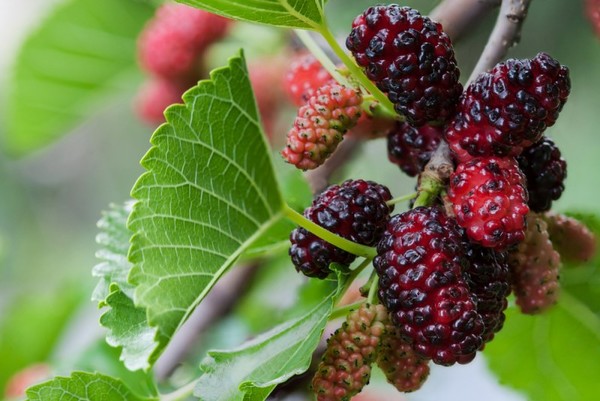
Mulberry fruits are similar to raspberries or blackberries, but its drupes are weaker adhered to each other.
Fresh berries are not stored for long. Even in the refrigerator, they will last for a maximum of 2-3 days. Fruits do not tolerate transportation either, even for a short distance. The berries need to be processed quickly.
The crop yield is high: on average, 100-200 kg of fruits are removed from an adult tree. Mulberry reaches such indicators by 10-12 years. And the first berries can be tasted 5–6 years after planting the tree in the ground.In addition to being eaten fresh, mulberries are frozen, used as a filling for baking, compotes, jams, and preserves are boiled.
The benefits and harms of fruits
Mulberries are extremely beneficial to health. They contain high concentrations of vitamins B, C, PP, as well as carotenoids, malic and citric acid, unsaturated fatty acids, essential oils, and iron. Mulberry is widely used in folk medicine. Its berries are an effective remedy for anemia and low hemoglobin levels in the blood. Also, their use is recommended for problems with the gastrointestinal tract, gallbladder and liver. Practice shows that mulberry berries have a positive effect on the work of the heart in case of hypertension, tachycardia, shortness of breath.
Do not abuse mulberry. With excessive consumption, it can cause a sharp jump in blood pressure (especially in the heat), and it contributes to an increase in blood sugar levels. Upset stomach and intestines are also possible. The intense color of the skin and juice turns mulberries into a strong allergen. The first time you need to use it very carefully, especially if you know about the hypersensitivity of your own body. It is undesirable to eat mulberries on an empty stomach and drink something cold.
Male and female plants
Depending on the species, the mulberry can be either monoecious or dioecious. It depends on whether the gardener needs one or more trees. In the second case, "male" and "female" plants are needed for fruiting. "Female" flowers are small, greenish, collected in a spike-shaped inflorescence. "Men's" are larger, almost white, similar to pendant earrings.
"Male" specimens are widely used in landscape design, they grow faster, they have more leaves.

Before the first flowering, it is impossible to determine whether this is a "female" mulberry plant or "male", therefore it is recommended to purchase seedlings at least 3 years old
Varieties and varieties popular with gardeners
Most of the "natural" species of mulberry fruits are practically tasteless. Most often grown in gardens are those whose berries have a pronounced taste - from sour to sugary-sweet. Breeders have bred many varieties of decorative mulberry.
White mulberry
The most common in Russia, it is highly frost-resistant (-30 ° C and more). On its basis, domestic breeders have developed many new varieties and hybrids. Leaves about 15 cm long, smooth, heart-shaped. Under optimal conditions, the height of the tree reaches 18–20 m, if they are far from ideal, the white mulberry turns into a shrub.
The crown is dense, in the form of an almost regular ball. The tree is very hardy, survives and bears fruit even in cities. It blooms in the last decade of May, the harvest ripens at the end of August. The bark is grayish-whitish. It is because of her that the white mulberry got its name. Fruits can be colored not only white, but also yellowish, pink, reddish and even almost black. Of all the mulberries, white is the sweetest.
The following varieties are most popular among gardeners:
- White honey. A hybrid of Russian selection. The tree is up to 10 m high. The crown is dense, shaped like a pyramid. The length of the drupe is about 3 cm. The berries are white, very juicy and sweet, with a pronounced honey aroma. The yield is consistently high - up to 200 kg per mature tree. It tolerates frost easily, quickly recovers from damage;
- White tenderness. It is valued for its frost resistance down to -40 ° C and the abundance of fruiting. The berries are snow-white, elongated, 3-4 cm long. If the summer is good in terms of the weather, the fruits ripen very sweet, but in wet and rainy weather the taste practically disappears. The first berries ripen in mid-June, fruiting lasts 6–8 weeks;
- Pink Smolensk. One of the novelties of selection. Begins to bear fruit in early June.Even 2-3-year-old trees yield crops. Leaves of an unusual decorative shape. The tree itself also looks elegant due to the fact that white, pinkish, pale scarlet berries hang on it at the same time. They are small (2–3 cm long), but this does not affect the yield in any way. Frost resistance - up to -35ºС;
- Fruit-1. Early variety, harvest ripens in June. Fruiting lasts 4-6 weeks. Drupes are white, but if spring and early summer are rainy, the skin takes on a pastel pink hue. The average fruit length is 2.5–3 cm. Productivity is up to 150 kg per adult tree. The fruits are sweet, juicy, but the pulp is quite dense. Of all varieties of mulberry, this one best tolerates transportation and is stored as long as possible;
- Ukrainian-107. The berries are large, 3–3.5 cm long. The skin is pale pink. The taste is sugary-sweet, the pulp is juicy, dense. The tree is frost-resistant, rarely suffers from diseases and pests. A significant disadvantage is low yield (15-25 kg);
- Merezhevo. Another new Russian hybrid. The harvest ripens in early July, fruiting lasts about a month. Drupes are creamy or pinkish, 3.5–4 cm long. The berries are very sweet. Overripe fruits quickly crumble;
- Black Baroness. The crop ripens in the second decade of July. It is appreciated for its unpretentiousness and frost resistance. The berries are large, 4 cm long and more, the skin is blue-black. The taste is sweet, dessert. The aroma is light, almost imperceptible. Fruits are stored for no more than 12 hours;
- The dark woman. Self-fertile hybrid, does not need pollinating varieties. The tree is tall, 15 m or more. The crown is wide, spreading. The berries are 3-4 cm long and have a sweet and sour taste. The skin is almost black. Productivity at the level of 150-200 kg, annual fruiting. The shelf life of fresh berries is 12-18 hours;
- Ukrainian-6. It is mainly used for feeding the silkworm or in landscape design, although the taste of the berries is sweet, dessert, the fruits are large (4–4.5 cm). The skin is colored black and purple. Frost resistance - up to -35ºС.
Photo gallery: varieties of white mulberry
- Mulberry White honey - a fairly large plant, it will need a lot of space on the site
- Mulberry White tenderness, ripe fruits are painted in a rare snow-white color, which is not found in nature
- Mulberry Rose Smolenskaya - one of the latest achievements of Russian breeders
- Mulberry Fruit-1 ripens in June
- Mulberry Ukrainian-107 gives very tasty berries, but there are not many of them on the tree
- Mulberry Merezhevo is practically not stored
- Mulberry Black Baroness is distinguished by undemanding care and frost resistance
- Mulberry Smuglyanka is a self-fertile hybrid; she does not need a "male" pollinator
- Mulberry Ukrainian-6 is mainly used as feed for silkworm
Black mulberry
In nature, it is found mainly in Afghanistan, Iran, less common in Italy. The average height of the tree is about 15 m, the crown is wide, spreading, the shoots are slightly numb. The bark is rough, dark brown. The leaves are large, up to 20 cm long. The inside is covered with thick soft pile. The average length of the fruit is 3-5 cm, the skin is inky purple or almost black.
The plant is undemanding to the quality of the soil, it is distinguished by drought resistance, it tolerates prolonged heat well. But the black mulberry is experiencing frost with difficulty. Therefore, in Russia, it can be grown only in the south, in a warm subtropical climate (Crimea, Caucasus, Black Sea region). From the countries of the former USSR, culture took root in Ukraine, in Moldova. But even in such conditions, it is recommended to make sure and build a winter shelter for the plant.
The following varieties of black mulberry are most often found in gardens:
- Fruit-4. The tree is not tall, 3-5 m, the crown is compact, spherical. Drupes are elongated, 4–4.5 cm long. The pulp is juicy, the taste is pleasant and refreshing. The yield is very high - 250 kg per tree or more, annual fruiting.Frost resistance at the level of -25 ° C. This variety is most popular among those who grow mulberries on an industrial scale. Due to the dense pulp, the berries tolerate transportation well;
- Istanbul. One of the largest-fruited varieties, the length of the drupe is 5–5.5 cm. The skin is dark purple, the flesh is juicy and sweet. Frost resistance - about -25ºС. Productivity is consistently high, annual fruiting. The variety is late, the harvest ripens in the first decade of August. The fruits are removed 4 years after planting the seedling in the ground;
- Shelley-150. One of the most popular varieties not only in Russia, but also in the world. Belongs to the category of early. The fruits are harvested in the last decade of June. The average length of the drupe is 5–6 cm. The skin is black, glossy shiny. The taste is sweet but not sugary;
- Galicia-1. The hybrid is widespread mainly in Ukraine. Drupes are very large, 6.5–8 cm long. The skin is violet-red, the taste is sweet, with a slight refreshing acidity. The yield is not too high - 35-50 kg;
- Black Prince. The variety is valued for its unpretentious care and resistance to adverse environmental factors (heat, drought, frost). The average length of the drupe is 4–5 cm. The skin is black, the pulp is sweet, with a slight honey flavor. It tolerates transportation well, it is stored for 2-3 days;
- Hartut. The variety is widely used in home winemaking. These berries have a very thick juice with a high (18–20%) sugar content. Even without processing to taste, it strongly resembles fortified dessert wine. The variety is self-fertile, bears fruit regularly and abundantly. The first fruits bears 3 years after planting;
- Hope. The average height of the tree is 8-10 m. The berries are of a very dark purple color, from a distance they seem black. Drupes are large, about 5 cm long, the pulp is sweet and sour. Ripe fruits stick well to the tree. Harvested in early July. A mature tree bears more than 100 kg of fruit annually.
Photo gallery: varieties of black mulberry
- Istanbul mulberry berries - presentable and tasty
- Mulberry Shelley-150 - one of the most popular varieties in the world
- Mulberry Galicia-1 stands out for its fruit size
- Mulberry Black Prince - one of the new varieties, devoid of significant drawbacks
- Hartut mulberry is held in high esteem by amateur winemakers
- Mulberry Nadezhda has a good yield and frost resistance
Red mulberry
The homeland of this species is North America. The average height of the tree is 10–12 m; the crown is shaped like a tent. Leaves about 10 cm long, rough to the touch.
Young leaves are cut out in the form of "lobes", then the shape is gradually smoothed out.
The fruits are sweet and sour, dark scarlet. The taste of red mulberry is extremely similar to blackberry. The plant is undemanding and hardy, is dioecious. It is appreciated for its high frost resistance.
Decorative mulberry
It is widely used in landscape design. It looks best in single plantings, often hedges are formed from it. The tree tolerates pruning well, the crown can be given almost any desired shape.
Popular varieties:
- Weeping. The average height of the tree is 3-4 m. The branches are thin, drooping. The leaves are small;
- Large-leaved. The leaves are heart-shaped, light green, on long stalks. The average length is 22–25 cm. The variety is thermophilic, quite rare;
- Spherical. The crown, even without formative pruning, turns into an almost regular ball. The height of the tree is 2–3 m;
- Pyramidal. The crown resembles a tall and narrow pyramid. The leaves are small;
- Tatarskaya. Rather not a tree, but a shrub or semi-shrub. The growth rate does not differ, it reaches a height of 2–2.5 m. The leaves are small. Winter hardiness is very high;
- Golden. Young shoots are indeed golden colored; as they mature, it changes to brownish. The average tree height is 2–3 m.Freshly opened leaves also have a pale golden hue;
- Red felt. Natural "mutation" of red mulberry. The front side of the young leaf is red, the back is whitish. Fruits are edible, purple-scarlet, but few;
- Narrow-leaved. Most often grown as a bush. The leaves are small, rough to the touch, strongly elongated and deeply dissected.
Photo gallery: decorative varieties and hybrids of mulberry
- Weeping mulberry looks impressive, but you can not expect a big harvest from such a tree
- The large-leaved mulberry is thermophilic, therefore it is practically not found in Russia.
- The spherical mulberry forms a neat crown practically without the participation of the gardener
- The pyramidal mulberry has small, often arranged leaves
- Tatar mulberry - decorative, but frost-resistant variety
- Golden mulberry looks very impressive
- The fruits of the red felted mulberry are edible
- Narrow-leaved mulberry stands out with its unusual leaf shape
Planting procedure and preparation for it
Mulberry is deservedly considered an unpretentious plant that successfully adapts to not the best conditions. But getting the maximum possible yields can be ensured only if you "listen" to the requirements of the tree and, if possible, satisfy them.
Seat selection
Like most other plants, mulberries love warmth and sunlight. An open, well-heated area is ideal for her. At some distance from the plant, it is desirable to have an obstacle that does not shade it, but protects it from gusts of cold north and north-west winds.
The best soil option is light fertile sandy loam or loam. And by planting a mulberry in a sandy substrate, you can kill two birds with one stone, strengthening the soil due to the developed root system of the tree. The plant has a negative attitude to heavy soil, but this problem can be dealt with by building an embankment about 0.5 m high or creating a drainage layer 10-15 cm thick at the bottom of the planting pit. yield in this case should not be counted. It is also undesirable for groundwater to be located closer than 1–1.5 m from the soil surface. This can provoke the development of root rot.
When choosing a place for mulberries, it is worth considering that this is a long-lived tree, moreover, it is quite large. If a single planting is planned, it must be placed at a distance of at least 5 m from other plants. When forming a hedge, seedlings are placed 1 m from each other.
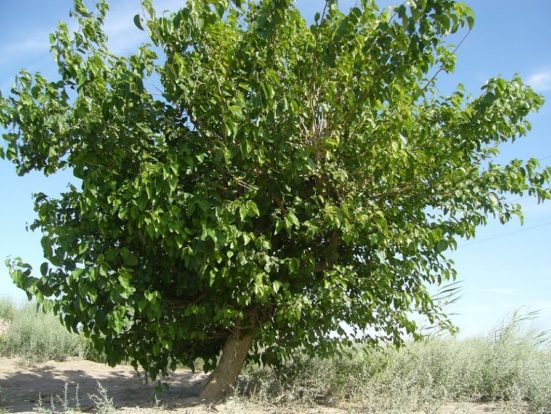
Mulberry is a large plant, this must be taken into account when choosing a place for it in the garden
Landing dates
In most of Russia (regions with a temperate climate), mulberries are best planted in a permanent place in spring, when the tree has not yet woken up from hibernation (leaf buds have not opened). Over the summer, the seedling will form a developed root system and adapt to new living conditions. This will allow him to survive the winter with minimal damage to himself.
Autumn planting (early September to mid October) is suitable for areas with tropical and subtropical climates. Winters in the Crimea, the Caucasus, the Kuban, the Krasnodar Territory, Ukraine are mild and almost always come in accordance with the calendar. When planning planting, it is worth considering that the tree needs at least 6 weeks to adapt. Practice shows that a seedling that has successfully endured the first winter will live long and bear fruit abundantly.
Pit preparation
The planting pit, about 70 cm deep and about the same diameter, is filled by a third with a mixture of fertile turf with humus or rotted compost. You can also add sifted wood ash (0.7–1 l), 20–30 g each of potash and phosphorus fertilizers, or about 50 g of a complex agent (Nitrofoska, Azofoska).Sprinkle this mixture with a thin layer of ordinary earth so that the roots do not suffer. The pit is prepared about 2 weeks before planting, if the procedure is planned for the fall, and if in the spring, then at the end of the previous season. At the bottom, a drainage layer is desirable (expanded clay, clay shards, brick chips).
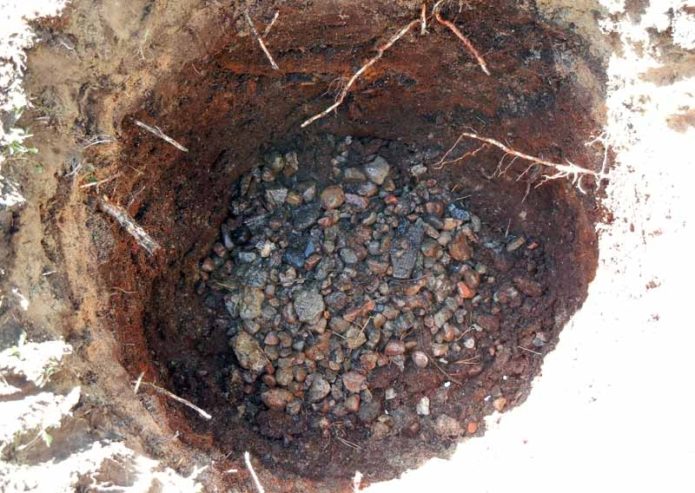
At the bottom of the mulberry planting pit, it is advisable to create a drainage layer so that moisture does not stagnate at the roots.
Landing
The disembarkation procedure itself has no peculiarities. The only caveat is that you don't need to shorten the roots before planting. If necessary, a support is placed in the pit in advance. The roots of the seedling need to be carefully straightened without damaging, they are quite fragile. The most important thing in the process is not to deepen the root collar. The soil is carefully trampled down, the tree is watered, spending 10-15 liters of water. When it is absorbed, the trunk circle is mulched with peat or humus, freshly cut grass.
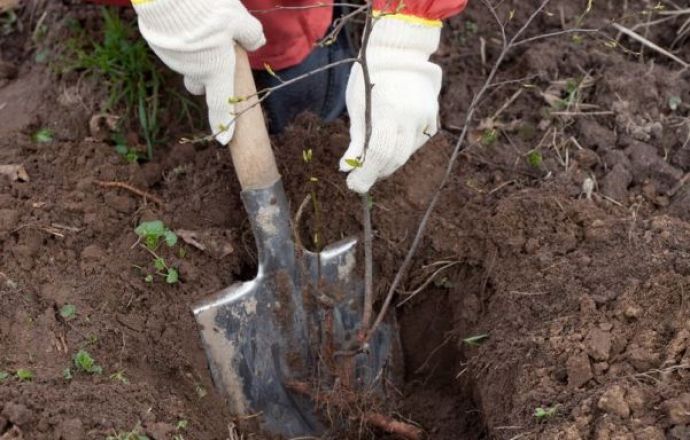
There is nothing complicated in planting mulberries, even a novice gardener can handle the procedure
Video: how to properly transplant mulberries
Nuances of culture care
Care comes down to maintaining the near-trunk circle in proper condition, periodic watering and feeding several times per season. The hardest part for the inexperienced gardener is the pruning procedure.
Watering
This culture does not need frequent and abundant watering. It is recommended to water the tree only if the weather is very hot and there is no rain. An adult mulberry needs 15–20 liters of water every 7–10 days.
Experienced gardeners advise against watering the tree in the second half of summer, thus preparing it for the coming winter rest period and sudden temperature changes. This is especially true for mulberries growing in the Moscow region and other regions with a temperate climate.
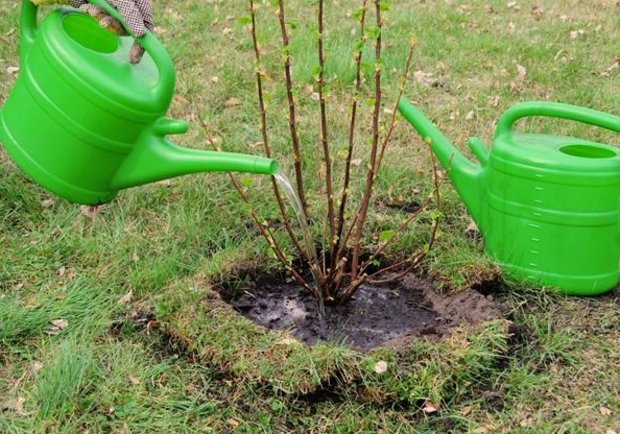
Only young mulberries are watered, and for an adult tree, if there is no abnormally strong heat outside, natural precipitation is quite enough
Particular attention should be paid to watering young trees under 5 years of age. Then the mulberry forms a developed root system and can provide itself with moisture on its own, pulling it out from the depths of the soil.
With a moisture deficit on young plants, the fruits become smaller, and annual shoots can freeze out in winter, without having time to ripen.
Fertilization
If the planting pit was prepared in compliance with all recommendations, the available mulberry nutrients will last for 2-3 years. But even after that, you should not get carried away with fertilizers, especially nitrogen-containing ones. Their excess negatively affects the immunity of the plant. Two dressings per season are quite enough.
- Immediately before the leaf buds bloom, 45–50 g of any complex fertilizer (Nitrofosk, Diammofosk, Azofosk) is added to the trunk circle. It is scattered over the surface of the soil in dry form, or a solution is prepared by diluting the specified amount in 10 liters of water. Once every 2-3 years, you can additionally distribute 15-25 liters of humus or rotted compost in the trunk circle.
- 2-3 weeks before the fruits ripen, mulberries are watered with diluted water infusion of fresh manure, bird droppings or nettle leaves, dandelion (a ratio of 1:15 for droppings and 1: 8 for everything else).
If the condition of the tree is not too good, it grows slowly; at the beginning of September, the soil in the tree trunk circle is sprinkled with sifted wood ash (0.5 l).
Pruning
Since the mulberry in nature reaches significant dimensions, pruning for it is a mandatory procedure. The plant easily transfers it, quickly recovering, even if the gardener "overdid it" a little.
Pruning has a positive effect on the yield of the plant, the size of the fruit increases markedly.
In regions with a temperate climate (Moscow region, Volga region, North-West), it is better to form mulberry not as a tree, but as a shrub or semi-shrub no more than 3 m high. For this, most of the shoots are cut off from a plant that has reached a height of 1.5 m, leaving 8-10 of the most powerful and developed ones. This will be the main "skeleton" of the structure. Then every year 2-3 of the oldest branches are cut to the point of growth, replacing with younger ones. Each of the skeletal shoots should have 3-4 branches of the second order and 10-15 branches of the third order.
It will take 3-4 years for the configuration to take its final form.
Where the climate for mulberry is close to optimal (Ukraine, Moldova, southern Russia), a tree that has reached a height of 1 m is shortened by cutting off the central shoot 25-30 cm above the last lateral one. Lateral shoots (with the exception of the three or four most powerful ones) are cut to the point of growth. The rest are shortened to 4–5 growth buds. Then, over the next 2–3 years, several more tiers are formed in the same way. Each of them should have 4–5 branches of the second and 12–15 branches of the third order. It is recommended to limit the total height of the tree to 4–5 m.
A spherical crown is also easy to form. To do this, the lower and upper shoots are shortened more than the middle tier - by about a quarter and a third, respectively.
Once the tree begins to bear fruit, the focus should be on sanitary pruning. It is carried out twice a year - in the spring before the "awakening" of the growth buds and in the fall, after the end of leaf fall. The air temperature in both cases must be above 0 ° C. It is imperative to get rid of broken, dried out, frozen shoots, affected by diseases and pests. Also, deformed, weak and poorly located branches are cut to the point of growth: thickening the crown, growing down, sharply knocking out of the given configuration.
Mulberry needs rejuvenating pruning every 10-15 years. All shoots are shortened by about a third, 2–3 skeletal branches are completely removed, replacing them with younger ones.
The fact that it is time to carry out the procedure is evidenced by a decrease in yield, shrinking fruits, curvature of shoots.
Video: tips for pruning mulberries
Harvesting
The fruiting period of mulberries is extended, often the berries ripen within 1.5–2 months. Due to such uneven ripening, on one branch, you can observe both completely green and bluish-black fruits.
The berries of the mulberry are small, there are a lot of them on the tree. Since they still do not differ in keeping quality, some gardeners save time on harvesting by spreading a film, a piece of cloth, newspapers under the mulberry. The tree should then be shaken vigorously several times.
Preparing for winter
Most of the mulberry varieties popular among gardeners can tolerate frosts down to -30 ° C without much damage to themselves. But only if the winter is snowy. Otherwise, the roots of the tree may suffer, even if the temperature drops to only -7-10 ° C. Therefore, it is advisable to build a shelter for the winter not only in regions with a temperate climate, but also in the subtropics.
- The trunk circle is cleaned of plant debris and shallowly loosened.
- The layer of peat or humus mulch is renewed, bringing its thickness to 12–15 cm. A hill 25–30 cm high is poured near the trunk.
- As soon as enough snow falls, it is raked to the trunk, building a snowdrift.
- Young trees can be closed entirely by wrapping them in burlap or other air-permeable covering material.
- In those varieties of mulberry, which are characterized by the presence of thin, drooping shoots, the branches are bent to the ground, throwing straw and spruce branches.
Do not be surprised if the mulberry growing in the Moscow region and other regions with a temperate climate sheds not only leaves, but also shoots in the fall.Due to the fact that the daylight hours in these areas are shorter than the crop requires, it has two growing seasons. In autumn, the mulberry independently forms a layer of cork-like tissue between the ripe and immature part of the shoot, thus getting rid of wood that will definitely not tolerate the cold.
Reproduction methods
Mulberry multiplies quite easily both vegetatively and generatively. The latter is used less often, since it is more laborious, takes more time and does not guarantee the preservation of the varietal characteristics of the “parent”.
Germinating seeds
The seeds are extracted from ripe berries, the color of which has acquired the color typical of the variety. They are thoroughly cleaned of pulp, dried and stored until spring in a dark, cool place, poured into linen or paper bags. The optimal time for sowing seeds is the end of April or the first decade of May.
- Sow them directly into the garden bed, deepening a maximum of 1–1.5 cm. In order to increase germination, you can soak them in Heteroauxin, Zircon, Kornevin for several hours.
- Before the emergence of seedlings, the garden bed is watered with a solution of any biostimulant (potassium humate, succinic acid, aloe juice, Epin) every 2-3 days. After - they switch to daily moderate watering with heated water.
- A canopy of white covering material is erected over the seedlings to protect them from direct sunlight.
- When 4-5 true leaves are formed, the plantings are thinned out, leaving at least 10-12 cm between them.
- After 2 years, the grown seedlings can be transplanted to the chosen place. The harvest from such a mulberry will have to wait at least 7-8 years.
Video: mulberry from seeds
Cuttings
This is the easiest way to reproduce, the success rate is 80-90%, even if you do not use special root stimulants. Mulberry stalk - the upper or middle part of a green shoot about 20 cm long, cut obliquely. Cuttings are harvested throughout the growing season. If the climate permits, they are planted in the ground in the fall. Otherwise, cuttings are dropped into a box with wet sand or peat until spring and kept at a temperature of 3-5 ° C.
The cuttings must have at least 2-3 growth buds. Semi-lignified branches can also be used, but the rooting process takes a long time in this case.
Cuttings are planted in a greenhouse or in a garden bed, positioned at an angle of about 45º, deepening by 3-4 cm. The lower leaves are removed completely, the remaining ones are cut in half. Cuttings planted in open ground are covered with glass caps, cut off with plastic bottles. It is imperative to maintain very high humidity, but make sure that rot does not appear.
If technical feasibility permits, it is desirable to create a "suspension" of small water droplets in the greenhouse, resembling fog.
Graft
This method is used to propagate the most valuable and decorative mulberry varieties. White mulberry is most often used as a stock. This is due to its unpretentious care and frost resistance.
The easiest way to vaccinate is to copulate. The top of the rootstock tree and the base of the scion seedling are cut at an angle, the cuts are aligned and tightly wrapped around the structure with electrical tape, adhesive tape or a special grafting tape. If the procedure is successful (new leaves begin to form on the scion), the harness can be removed. A prerequisite is that the scion and rootstock should be approximately the same thickness.
Budding requires a certain amount of experience from the gardener.As a scion, not a whole branch is used here, but one growth bud, cut off together with the "shield" from the surrounding tissues with a thickness of no more than 2-3 mm. This “flap” is inserted into an X- or T-shaped incision in the rootstock bark. The whole structure is securely fixed. If the growth bud hatches after 2–3 months, the stock is cut 10–15 cm above the graft site, removing all lateral shoots.
Diseases, pests and control of them
Mulberry is distinguished by good immunity; this culture rarely suffers from diseases and pests. But she is not insured, so you need to be able to recognize suspicious symptoms and know what to do in each case.
Diseases typical for culture:
- powdery mildew. Leaves, shoots, fruits are covered with grayish-white "fleecy" bloom. Gradually, it darkens and thickens, the affected tissues die off. Thickening of the crown and intense heat contribute to the spread of the disease. For prevention, mulberries and soil in the trunk circle are powdered with crushed chalk and sifted wood ash. Fundazol or Fitoverm-M will help to cope with the problem. It is advisable to shed the trunk circle with a pale pink solution of potassium permanganate;
- cylindrosporiasis. The leaves are covered with multiple, well-defined dark scarlet or crimson spots. Then the affected areas turn yellow, the leaves dry and fall off. If characteristic symptoms are found, the tree and soil in the near-trunk circle are sprayed with a 1% Silit solution. After 12-15 days, the treatment is repeated;
- bacteriosis. The first symptom is dark blurry irregular spots on leaves and shoots. Gradually they turn into depressed "ulcers". Damaged leaves roll up into a tube and fall off, gum is released on the shoots. It is possible to cope with the disease only in the early stages of its development, by cutting off all minimally affected parts of the plant and treating it with Fitolavin, Gamair;
- curly leaves. The surface of the leaf wrinkles, "nodules" appear on it. The sheet plate becomes smaller and deformed. It is impossible to cure this viral disease with modern means. Particular attention should be paid to prevention, primarily the fight against carriers of the pathogen (aphids, thrips, spider mites);
- tinder fungus. The spores of the fungus penetrate the tissues through mechanical damage in the cortex. Growths appear on the shoots that destroy wood. They need to be cut off with a sharp sterile knife, the wound should be washed with 5% copper sulfate and covered with garden varnish or a mixture of fluff lime, cow dung and powdered clay. You can also paint the cut with several coats of oil paint.
Photo gallery: symptoms of common mulberry diseases
- Powdery mildew on the plant seems to be a harmless bloom that can be easily erased.
- Bacteriosis is treatable only at an early stage of development
- Leaves curl negatively affect plant development and yield
- Tinder fungus is a parasite that severely damages mulberry wood
The most common pests:
- Ifantria American (white American butterfly). The larvae of this butterfly are able to completely devour the leaves in a matter of days, leaving only veins. For prevention, unblown leaf buds and soil in the near-stem circle are sprayed with Nitrafen or Karbofos. To scare off adults from the plant, use Chlorophos, Phosphamide, Antio, Saifos. One treatment every 3-4 weeks is enough;
- mealybug. A whitish bloom appears on the leaves, shoots, buds, fruits, resembling scattered flour. The affected parts of the plant turn yellow, dry and fall off. For prevention, mulberries are sprayed with an infusion of onions, garlic, any pungent-smelling herbs about once a week. To cope with the pest, they use Mospilan, Tanrek, Confidor-Maxi.Usually 2-3 treatments are enough with an interval of 8-12 days;
- spider mite. Young leaves, tops of shoots, buds are intertwined with thin threads, similar to cobwebs. Affected plant parts become discolored, deformed and dry out. For prevention, mulberries are sprayed weekly with infusion of onion or garlic gruel, decoction of cyclamen tubers. They fight the pest using acaricides (Actellic, Apollo, Neoron, Omite). It will take 3-4 treatments with an interval of 5-12 days. The hotter it is outside, the more often the plant is sprayed.
Photo gallery: what pests dangerous for the culture look like
- The main harm to mulberries is caused by the caterpillars of the American ifantria
- To combat mealybugs, they mainly use general-purpose insecticides.
- To combat spider mites, special preparations are used - acaricides
Until recently, the cultivation of mulberries in temperate climates was not possible. But the breeders corrected this situation by developing several frost-resistant varieties. Now nothing prevents the spread of this tasty and healthy berry in Russia. The rapid growth of its popularity is facilitated by a consistently high yield, unpretentious care, decorativeness of the tree.
